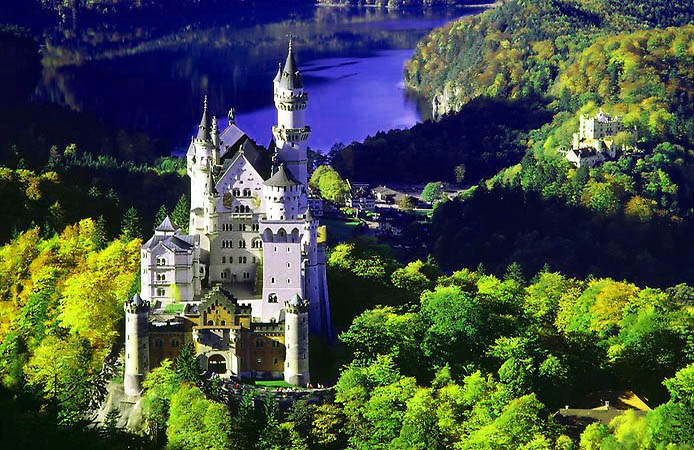
The Neuschwanstein Castle built in honor of knights of the German epos is the embodiment of dream of the king Ludwig II Bawarski and artistic images of the composer Richard Wagner. Romantic fairy tale. The fruit of passionate interest of the king Ludvig in opera statements, Neuschwanstein Castle, in turn, inspired many artists during creation of scenery for ballet and theatrical performances. This magic castle – the only place on light which could serve as a prototype of the palace of the princess for Walt Disney’s movie “Sleeping Beauty”. Elegantly decorated Singing hall in which still annually, in September, there take place Wagner concerts gives the flavor about magnificent internal furniture of the lock. Walls of the hall are painted with scenes from a legend of Persifala, and of love of the king Ludvig to this legend it is possible to judge by a lock Throne-room. Fantastic Neuschwanstein Castle towers over the gloomy gorge in the Bavarian Alps on which bottom the river Pollack flows. It seems that towers of this magic castle of color of an ivory soar against dark green fir-trees. Noyshvanshtayn who is thought up and constructed by the king Ludwig II (1845-1886) looks more “medieval”, than the real medieval constructions. The incarnate dream of infinitely rich person, the lock represents quintessence of theatricality in architecture. Dreams of locks were born at Ludwig in the childhood. From early age he liked to participate in theatrical representations and to dress up. Summer the family carried out to Gogenshvangau, an entail property of Shvangau which Ludwig’s father Maximilian II got in 1833. The few romantic, Maximilian for work on the project of restoration of the lock employed not the architect, but the artist-set designer. Walls of the lock were painted with scenes from different legends, especially from a legend of Loengrin, “the knight with a swan” who, according to the legend, lived in Gogenshvangau. When Ludvig, the shy, sensitive and having rich imagination young man, for the first time heard the opera – it was “Loengrin”, – he was shocked. He immediately asked the father to invite the composer Richard Wagner (1803-1883) to put a performance anew and only for it one. It laid the foundation to relationship which was not interrupted throughout all life of Ludvig, In 1864 Maksimilian died and 18-year-old Ludvig ascended to the Bavarian throne. Exactly in six weeks he sent for Wagner and invited him to live on one of the Munich country houses. Though Ludvig not really understood music, he gave money and advice, criticized and tried to inspire the composer. It was so attracted by Wagner’s music because he dreamed to create the fine fairy tale with fantastic palaces. And the most beautiful of palaces fairy tales Noyshvanshtayn became very first. In the spring of 1867 Ludvig visited Gothic Wartburg Castle. The lock fascinated him, Ludvig tested thirst for all theatrical and romantic. He wanted to have just the same. In one and a half kilometers from Gogenshvangau, the palace of his father Maksimilian, on the rock there was a destroyed watchtower. This rock, Ludvig solved, and its will serve as a building site for Noyshvanshtayn, “the new house with a swan”. On September 5, 1869 to the base of the main building – the Oriental carpet – the first stone was put. The Neuschwanstein Castle devoted to the knight Loengrin originally reflected as three-storyed Gothic fortress. Gradually the project underwent changes until the Oriental carpet turned into a five-floor construction in Romance style that most of all, according to Ludvig, corresponded to a legend. The idea of the yard of the lock was borrowed from the second act of statement of that time of “Loengrin” where action was developed in the yard of the Antwerp lock. The idea of the Singing hall was cast by the opera “Tangeyzer”. Tangeyzer was the German poet living in the 13th century. According to a legend, it found the road to Venusberg, the underground world of love and beauty which was operated by the goddess Venus. One of scenes of Wagner “Tangeyzer” was put in the Singing hall Vartburga therefore Ludvig enjoined to reproduce it in Noyshvanshtayna. Besides, he wanted to create in the lock the most beautiful “Venus’s grotto”, but as for it there was no suitable place, was forced to be satisfied with its imitation within the walls of the lock. In the same place the small falls were built and the artificial moon hung. (The real grotto was built approximately in 24 km to the East from Noyshvanshtayn, in Linderkof, the former hunting lodge turned by Ludvig into a tiny shato in the Versailles style.) The king matured, and Loengrin and Tangeyzer’s lock turned into the lock of the Saint of Graal from the opera “Persifal”. Loengrin’s father, Persifal, was a knight of the Round table who beheld Sacred Graal – a bowl with the Savior’s blood. Projects of the hall of Sacred Graal conceived by Ludvig in the middle of the 1860th years were embodied in Noyshvanshtayn Throne-room where highly the white marble ladder conducting to an empty platform rises up – the throne never stood on it. Walls of the Singing hall were in addition painted with scenes from the opera.


Leave a Reply